Analysing Sound Waves
- Sounds are mechanical waves. They are caused by vibrating objects. The string of a guitar, the skin of a drum and a tuning fork, all of these vibrate to produce sound.

- The vibrating cone of a loudspeaker in Figure produces sound. Its vibrating diaphragm is continually compressing and stretching the air next to it. This makes a series of compressions and rarefactions which travel through the air away from the loudspeaker.
- A compression is a region of increased pressure and a rarefaction is a region of decreased pressure. The resulting succession of compressions and rarefactions constitutes the sound waves.

- A sound wave is longitudinal in nature because the air molecules vibrate in the direction which is parallel to its direction of propagation.
- A sound wave needs a medium for its propagation because its propagation is essentially due to the vibration of the molecules of its medium.
- Compressions and rarefactions need a material which can be compressed and stretched. This explains why we do not hear any sound in space which mainly consists of a vacuum.
People also ask
- What is Sound and How is it Produced?
- What are the Different Types of Sound?
- What are the Characteristics of Sound Waves?
- What is Echo and Sonar?
- Analysing Reflection of Waves
- Analysing Refraction of Waves
- Analysing Interference of Waves
- Analysing Diffraction of Waves
- Analysing Electromagnetic Waves
Amplitude and Frequency of Sound Waves
- The amplitude of sound waves is related to its loudness. The louder the sound, the bigger is its amplitude.
- The frequency of sound waves is related to its pitch. The higher the pitch of the sound, the higher is its frequency.
- Figure summarises the relationship between, amplitude and loudness; frequency and pitch of a sound.
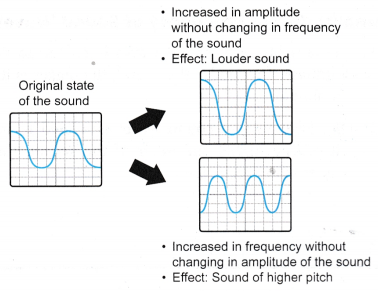
Application of Sound Waves in Daily Life
- Sound can be generated in a wide range of frequencies. Sound waves generated between 20 Hz and 20 kHz can be heard by normal human ears and are known as audio waves. Those below 20 Hz are called infrasonic and those above 20 kHz are known as ultrasonic.
- A bat can navigate in complete darkness by emitting very high-pitched sound waves in the ultrasonic range.
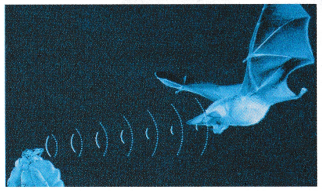 (a) When these waves hit an object, they are reflected back and received by the bat.
(a) When these waves hit an object, they are reflected back and received by the bat.
(b) The time between the emission of the sound waves and the reception of the reflected waves enables the bat to estimate the position of the object accurately. - Dolphins use ultrasonic frequencies of about 150 kHz for communication and navigation.
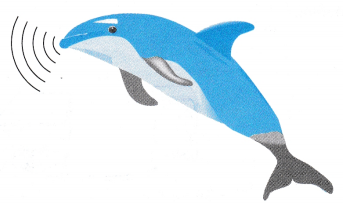
- Figure shows the process of detecting flaws inside a piece of metal using the echo sounding method.
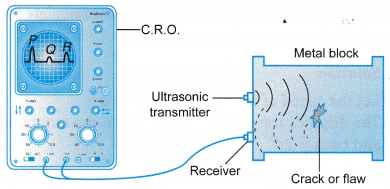 (a) An ultrasonic transmitter sends out pulses of ultrasound in the metal.
(a) An ultrasonic transmitter sends out pulses of ultrasound in the metal.
(b) A receiver picks up the echoes from different parts of the metal and sends the information to a C.R.O.
(c) The C.R.O. displays the information on its screen. Pulse P is the transmitted pulse, pulse Q has been reflected by the flaw and pulse R is the echo from the end of the metal. - An ultrasonic ruler uses ultrasonic echoes to measure distance. Figure shows an ultrasonic ruler being used to determine the depth of the sea.
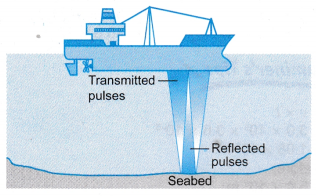 (a) Pulses of ultrasounds are directed from the ship to the seabed and a receiver attached to the ship detects the reflected pulses.
(a) Pulses of ultrasounds are directed from the ship to the seabed and a receiver attached to the ship detects the reflected pulses.
(b) The time taken by a pulse to travel to the seabed and return to the ruler enables the depth of the sea to be determined. The ruler can be calibrated to give the value of the depth directly. - Opticians and goldsmiths use ultrasound to clean spectacles, jewellery and ornaments. The water used for the cleaning purpose is vibrated by ultrasound. The vibrations shake off dirt attached to these objects.
- Dentists use ultrasonic waves to vibrate and shake dirt and plaque off patients’ teeth.
- Animals like elephants and rhinoceroses call to one another using infrasonic waves.
Amplitude and Frequency of Sound Waves Experiment
Aim: To study the effect of amplitude on the loudness and frequency on the pitch of sound.
Apparatus: Cathode ray oscilloscope (C.R.O.), audio signal generator, loudspeaker
Method:

- The apparatus is arranged as shown in Figure.
- The audio signal generator and C.R.O. are adjusted so that a sound is produced by the loudspeaker and a sine wave is observed on the screen of the C.R.O.
- By fixing the frequency, the volume*of the audio signal generator is increased gradually. The observation is recorded.
- By fixing the volume, the frequency of the audio signal generator is increased gradually. The observation is recorded.
Observation:
| Adjustment done on the audio signal generator | Change in the sine wave on the screen of the C.R.O. | Change in the sound produced by the loudspeaker | ||
| Volume | Frequency | Amplitude | Frequency | |
| increased | Fixed | Increased | Unchanged | Louder |
| Fixed | Increased | Unchanged | Increased | FHigher pitch |
Conclusion:
Based on Table, it can be concluded that
(a) the bigger the amplitude of the sound, the louder is the sound.
(b) the higher the frequency of the sound, the higher is the pitch of the sound.